National Parks and Game Reserves in Tanzania
Tanzania National Parks, Tanzania is one of the greatest tourist destinations in the world, the country is a great habitat for a variety of tourist attractions ranging from wildlife, birds, mountains, lakes, rivers, hills, and many more. Tanzania’s tourist attractions are protected in a number of protected areas categorized as a national park and national reserve, these reserves include.
List of Tanzania National Parks
Serengeti National Park
Serengeti national park is the most popular reservation Tanzania national parks and a UNESCO world heritage site located in northwestern Tanzania bordering the Kenyan border to the north, Serengeti national park is continuous best Tanzania national parks with Masai Mara and is name after the Masai word Siringet meaning the Endless plain. Serengeti national park in Tanzania is one the greatest destination in the world for wildlife viewing, best camping in Tanzania national parks and famous for experiencing the great wildebeest migration which involves the migration of millions of wildebeests, gazelles, and zebras from and to Masai Mara national park.

Tanzania national parks and game reserves, Birdlife in Serengeti national park comprises over 500 bird species with resident and migratory bird species, these birds include Black-headed Gonolek, Fischer’s lovebird, Green-backed Woodpecker, Grey-backed fiscal, Grey-breasted Spurfowl, Grey-crested helmet-shrike, Hildebrandt’s starling, Red-capped robin-chat, Rufous-tailed Weaver, Rüppell’s Vulture, Southern ground hornbill, Schawlow’s turaco, Silverbird, Usambiro barbet, Verreaux’s eagle, Yellow-throated sand grouse and many more. Serengeti national park also comprises of retina hippo pool, Masai kopjes, Moru Kopjes, lower Grumenti woodlands, Lake Ndutu, Kusini plains, Gol Kopjes, Barfufu Gorge and Kopjes, Simba Kopjes, Makoma hill, Matiti plains, Olduvai Gorge, Seronera valley, Lamai Triangle, Mara River, upper Grumeti woodlands and Lobo valley.
Safari activities to do in Serengeti national park include game drives, bird watching, balloon safaris, cultural tours, and walking safaris.
Learn More about Serengeti National Park
Arusha National Park
Arusha national park is an iconic wild site in East Africa located in north-eastern Tanzania located close to Arusha town and right next to the Kenyan border, the park also lies at a distance of 35 kilometers from Arusha town.

This park is the second oldest Tanzania national parks and game reserves, it covers an area of 552 square kilometers encompassing Mount Meru a prominent volcanic, Mount Meru is the second-highest mountain in Tanzania standing at an elevation of 4,566 meters above sea level. The top of this volcano comprises the Ngurdoto crater which is reached on a mountain climbing safari in Tanzania.
Arusha national park boasts a wide range of wildlife of all Tanzania national parks and birdlife, animals in Arusha national park include giraffes, elephants, leopards, wild cats, spotted hyenas, lion, bush pigs, dik-dik, waterbucks, hippos, black and white colobus monkeys, duikers, and many more.
There are over 300 bird species in Arusha national park with both migratory and resident species, birds in this park habit mostly around the shores of lakes in the park that are Momella lakes and various vegetation covers. These birds include African fish eagle, African olive pigeon, Augur buzzard, Bar-tailed trogon, Bearded vulture, Black saw-wing, Cinnamon-chested bee-eater, Egyptian goose, Great crested grebe, Hartlaub’s turaco, Little grebe, Narina trogon, Peregrine falcon, Red-fronted parrot, Scaly francolin, Silvery-cheeked hornbill, Southern pochard, Tawny eagle, Verreaux’s eagle and many more.
Safari activities to do in Arusha national park include game viewing, mountain Meru climbing, walking safaris, birding, canoeing safari, and horseback safaris.
Learn More about Arusha National Park
Gombe Stream National Park
Gombe stream national park in Tanzania is located in the western Kigoma Region, this park is one of the smallest parks in Tanzania living along the hills of the eastern shores of Lake Tanganyika. Gombe stream national park was established in 1968 covering an area of 52 square kilometers, the park is composed of steep valleys, grasslands, woodlands, and tropical rainforests.

Gombe stream national park is a famous national parks in Tanzania Africa for being a site where Jane Goodall research conducted research on olive baboons, chimpanzees, vervet monkeys, red-tailed monkeys, blue monkeys, and many other primates.
Gombe stream national park in Tanzania is home to primate species, mammals, and bird species. Primates in this park include chimpanzees, Olive baboons, chimpanzees, vervet monkeys, red-tailed monkeys, and blue monkeys, other animals include bush pigs, hippopotamus, leopards, and many more.
Gombe Stream national park is a habitat to over 200 bird species such as the common African Fish eagle, the Common paradise flycatcher, Tropical Boubou, Livingstone’s turaco, African broadbill, double-toothed barbet, crowned eagle, and Golden-rumped tinker bird, and many more.
Things to do in Gombe Stream national park include fishing, hiking, boat rides, swimming, guided nature walks, chimpanzee tracking, and bird watching.
Learn More about Gombe Stream National Park
Katavi National Park
Katavi national park in Tanzania is a safari gem located in the western part of Tanzania in a distance of about 40 kilometers south of Mpanda town, the park lies in the shortened arm of the Great Rift Valley. Katavi national park was the first protected area to be gazetted during the German administration in Tanzania in 1911, the park was later renamed the Rukwa Game reserve and in 1998 it was officially opened as Tanzania best national parks covering an area of 4,471 square kilometers.

Katavi national park is dominated by forests, seasonal pools, and lakes in Katsunga plain, miombo woodland, and wooded savannah, the park boasts a variety of wildlife and birdlife species.
Animals in Katavi national park include elephants, buffaloes, antelopes, zebras, crocodiles, hippos, giraffes, elands, topis, waterbucks, hartebeests, impalas, and many more.
Birdlife in Katavi national park consists of over 450 bird species and they include herons, plovers, spoonbills, African open bills, storks, African paradise flycatchers, African spoonbills, black cuckoo-shrikes, orange-breasted bush shrikes, crested barbets, little bee-eaters, red-billed hornbills, and many more. Katavi national park protects Katuma and Lake Katavi from which the park gets its name.
Safari activities to do in Katavi national park include game drives, birding, walking safaris, and camping.
Learn More about Katavi National Park
Jozani Chwaka Bay National Park
Jozani Chwaka Bay national park in Tanzania is found on Zanzibar Island covering an area of only 50 square kilometers, this park is the only national park in Zanzibar and situated adjacent to Jozani city.

Jozani Chwaka Bay national park is famed for being a habitat to a huge population of red colobus monkeys locally known as Kirk’s red colobus monkeys, this park is a habitat to other primate species such as bush babies, skyes monkeys, white and black colobus monkeys.
In Jozani Chwaka Bay national park there are four-toed nocturnal tree hyrax, Zanzibar leopard, Ader’s duiker, and Zanzibar servaline genet, 40 species of butterflies, and 40 species of birds.
Birds in Jozani Chwaka Bay national park include African fish eagles, sunbirds, pelicans, vultures, spoonbills, kingfishers, and many more
Safari activities to do in Jozani Chwaka Bay national park include game viewing, guided walking safaris, and cultural visits.
Learn More about Jozani Chwaka Bay National Park
Kilimanjaro National Park
Kilimanjaro national park is a UNESCO World Heritage site and a scenic destination located in the Kilimanjaro region near Moshi city in the Northern region of Tanzania, the park lies is a distance of 300 kilometers south of the equator and lies in the northern safari circuit of Tanzania.

Kilimanjaro national park stretches around Mountain Kilimanjaro the tallest free-standing mountain on the continent of Africa, this mountain is also the 4th most topographically prominent peak on earth.
Mountain Kilimanjaro consists of a snow-capped summit that is the top tourist attraction in the park creating a scenic view, the mountain is composed of 3 distinct cones that are Kibo at 5,895, Mawenzei at 5,149, and Shira at 4,005 meters. Mountain Kilimanjaro national park covers an area of 1,688 square kilometers protecting various species of wildlife, birdlife, and other physical features.
Animals found in Mount Kilimanjaro national park include black and white colobus monkeys, blue monkey, forest duikers, grey duikers, cape buffaloes, hyrax, myosorex zinki, elands, elephants, bush babies, leopards, zebras, hyenas, and many more.
Birdlife in Kilimanjaro national park consists of over 179 bird species including silvery cheeked hornbill, violet crested turaco, and rose turaco, natrina trogon, trumpeter hornbill, white brown Coucal, African pygmy kingfisher, malachite kingfisher, African pitta, and many more.
Safari activities to do in Mount Kilimanjaro national park include mountain trekking, mountain cycling, bird watching, wildlife viewing, picnic safaris, guided nature walks, and cultural safaris.
Learn More about Mount Kilimanjaro National Park
Kitulo National Park
Kitulo national park in Tanzania is located in the Mbeya and Njombe region covering an area of 412.9 square kilometers, this park is the first park in tropical Africa to be established to protect flora.

Kitulo national park was first established in 2002 and in 2005 it was gazetted as a national park, the park protects montane grasslands on the Kitulo plateau with 45 endemic orchids and 350 wildflower species.
Kitulo national park is home to a variety of wildlife species and birdlife, wildlife in the park includes the 25 most endangered primates, animals in this park include reedbucks, Angola pied colobus, blue monkey, Kipunji monkey, lizards, chameleons, lizards, and butterflies.
Birds in Kitulo national park include cisticola, kipengere seedeater, endangered blue swallow, Denham’s Bustard, and many more.
Safari activities to do in Kitulo national park include swimming, mountain climbing, hiking, and bird watching.
Learn More about Kitulo National Park
Lake Manyara National Park
Lake Manyara national park is a scenic national park in Tanzania located in both Arusha and Manyara regions and lies in the Great Rift Valley, Lake Manyara national park covers an area of 230 square kilometers with a topography consisting of Lake Manyara a shallow alkaline lake formed in a depression in the rift valley system.
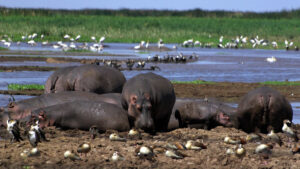
Lake Manyara national park is well known for tree-climbing lions and flocks of pink flamingoes, the park protects a variety of resident bird and wildlife species.
Animals in Lake Manyara national park include tree-climbing lions, zebra, bushbuck, waterbuck, Grant’s gazelle, impala, Thomson’s gazelle, Cape buffalo, giraffe, hippopotamus, baboon, warthog, elephant, wildebeests, leopard, African wild cat, spotted hyena, black-backed jackal, bat-eared fox, serval, honey badger, African civet, genet (Genets) species, mongoose species. Cheetah and African golden cats and many more.
Birdlife in Lake Manyara national park consists of over 300 bird species including resident and migratory bird species, birds in Lake Manyara include flocks of flamingoes, Silvery-cheeked Hornbill, Narina Trogon, Crowned Hornbill, Schalow’s Turaco, Emerald Cuckoo, Crowned Eagle, ground-dwelling Crested Guineafowl, Crowned Plover, Grey Crowned Crane, Fischer’s Sparrow Lark, Two-banded courser, Black-faced Sand grouse and many more.
Safari activities to do in Lake Manyara national park include game viewing, birding, cultural visit to Masai Bombas, canoeing safaris, and walking safaris.
Learn More about Lake Manyara National Park
Mahale Mountains National Park
Mahale Mountains national park in Tanzania is one of the most scenic destinations located in western Tanzania and lies on the north shores pf Lake Tanganyika.

Mahale Mountains national park is dominated by Mahale ranges stretching from Rift Valley Escarpment from the shores of Lake Tanganyika to Nkungwe peak of 2,462 meters above the sea level.
Mahale Mountains national park is a famous habitat for chimpanzees with over 1,000 individuals, chimpanzees live in a group of 60 individuals with habituated groups such as Mimikere group.
Other wildlife species in Mahale Mountains national park include yellow baboons, red-tailed monkeys, vervet monkeys, red colobus, blue monkeys, blue monkeys, lesser and greater galagos, buffaloes, giraffes, bushbucks, waterbucks, elephants, lions, wild dogs, and many more.
Birdlife in Mahale Mountains national park are more than 350 bird species and they include hornbills, giant kingfisher, crested guinea fowl, African fish eagles, Ross’s turaco and many more.
Safari activities to do in Mahale Mountains national park include chimpanzee tracking, mountain biking, sport fishing, boating safari, birding, snorkeling, Kayaking, and cultural tours.
Learn More about Mahale Mountains National Park
Mikumi National Park
Mikumi national park in Tanzania is located near Morogoro in Mikumi, the park is crossed by A7 Highway. Mikumi national park covers an area of 3,230 square kilometers bordering Selous Game reserve in the south, the landscape of this park comprises Malundwe Mountain with a belt of hills running from east and west through the park.
Mikumi national park is home to a concentration of animals such as lions, elephants, giraffes, impalas, sable antelopes, warthogs, greater kudus, wildebeests, baboons, impalas, hartebeests, zebras, wild dogs, crocodiles, and hippos. Birdlife in Mikumi national park consists of more than 400 species of birds, these species include colorful lilac-breasted roller, yellow-throated long claw, Bateleur eagle, African spoonbills, hammer lop, African open bills fishing African fish eagle, and many more.
Safari activities to do in Mikumi national park include game viewing, walking safaris, bird watching, cultural tours, picnic and camping
Mkomazi National Park
Mkomazi national park in Tanzania is located in northeastern Tanzania in Kilimanjaro and Tanga region along the Kenyan border, this park is contiguous to Tsavo West national park in Kenya.
Mkomazi national park was established as a game reserve in 1951 and later upgraded to a national park in 2006 covering an area of 3,234 square kilometers, the area of the park is typically dominated by Acacia Commiphora vegetation.
Wildlife in Mkomazi national park consists of 78 species of mammals such as Giraffe, oryx, gerenuk, hartebeest, lesser kudu, eland, impala and Grant’s gazelle share the reserve with elephant, buffalo, lion, leopard, cheetah, and many more. There are also birds in Mkomazi national park with over 450 bird species and they include cobalt-chested vulturine guinea fowl, large ground birds such as ostrich, Kori bustard, secretary bird, ground hornbill, and many more. Mkomazi national park receives migratory bird species such as the European roller present from November to April.
Safari activities to do in Mkomazi national park include Game drives, camping, site seeing, bird watching, walking safari, and hiking.
Ruaha National Park
Ruaha national park is the largest national park in Tanzania located in south-central Tanzania and situated at a distance of about 130 kilometers from Kizigo-Muhesi ecosystem and 455 kilometers from Nyerere International airport, this park lies on the east side of the Great Rift Valley bordering Selous game reserve in the west and Serengeti national park in the south.
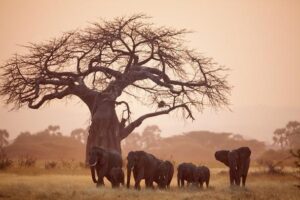
Ruaha national park covers an area of 20,226 square kilometers protecting flora, fauna, rolling hills, rocky escarpments, rolling hills, and vast plains dotted with Baobab trees. Fauna species in Ruaha national park include over 1650 plant species, baobab trees, acacia vegetation, and many other species. Fauna in Ruaha national park includes the largest population of elephants in Africa, other mammals in this park include lions, leopards, wild dogs, cheetahs, giraffes, zebras, elands, impalas, bat-eared foxes, jackals, topi, roan antelopes, hartebeests, and many more.
Ruaha national park is crossed by numerous rivers such as Ruaha river from which the park derives its name, Lukosi River, Yovi River, Kitete River, Sanje River, Little Ruaha, Kisigo River, Mbarali river, Kimani river, and Chimala river. There are also small rivers which include Umrobo River, Mkoji River, Lunwa River, Mlomboji river, Ipatagwa river, Mambi, and Mswiswi river.
Ruaha national park offers a couple of safari activities such as walking safaris, game viewing safaris, and bird-watching safaris
Learn More about Ruaha National Park
Rubondo Island National Park
Rubondo island national park in Tanzania is one of the two only Tanzania national parks located on an island in Lake Victoria, the park is located in the south-western corner of Lake Victoria on Rubondo Island. Rubondo Island lies in a distance of 150 kilometers west of Mwanza, Rubondo island national park is made up of Rubondo Island and several other small islands of Lake Victoria.
Rubondo island national park was established in 1965 covering an area of 456.8 square kilometers, the park boasts a rich and diverse eco-system consisting of birdlife, wildlife, and butterflies. The park habits animals such as the rare sitatunga antelopes, elephants, giraffes, chimpanzees, bush pigs, suni, bushbucks, hippos, elephants, giraffes, crocodiles, and many more.
Rubondo island national park is a breeding site for water birds and habits a high density of fish eagles, other birds found in Rubondo island national park include grey parrots, African fish eagles, ibises, egrets, herons, Kingfishers, flamingoes, sunbirds, and vultures, open billed, flamingoes, vultures, open billed marabous storks, grey parrots, marabou storks and many more.
Rubondo Island national park offers safari activities such as bird watching, game viewing, guided nature walks, canoeing and boat rides, fishing, primate tracking,
Saadani National Park
Saadani national park in Tanzania the only national park in Tanzania boosting the forefront of the Indian Ocean as it is located along the shores of the Indian Ocean.
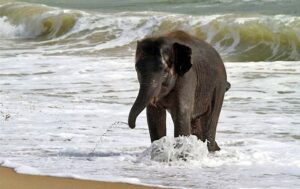
Saadani national park was established as a national park in 2005 covering an area of 1100 square kilometers protected a variety of wildlife species, animals found in Saadani national park include lions, African bush elephants, Cape buffaloes, and leopards. Masai giraffes, Lichtenstein’s hartebeest, waterbucks, blue wildebeests, Bohor reedbucks, common and red duikers, Dik-Dik, yellow baboons, vervet monkeys, blue monkeys, Colobus monkeys, mongooses, genets, porcupines, sable antelopes, warthogs, hippopotamuses, crocodiles, and Nile monitors.
Saadani national park is a great birding habitat with over 250 bird species such as African cuckoo hawk, African skimmer, Greater flamingo, Lanner falcon, lesser kestrel, little bittern, Long-crested eagle, Pel’s fishing owl, and many more.
Safari activities to do in Saadani national park are game drives, guided walking safaris, boat trips, swimming, and visiting Saadani fishing village.
Saanane Island National Park
Saanane Island national park in Tanzania is located on an island in Lake Victoria in Mwanza, the park lies in about 10 minutes boat drive from TANAPA offices on Capri Point in Mwanza town.
Saanane Island national park is the smallest national park in Tanzania and is a home to mammals like Impala, Rock Hyrax, velvet monkeys, wild cats, De-brazas Monkey, crocodiles, Monitor Lizards, Agama Lizards, Pancake and Leopard Tortoises, Snakes particularly Python.
Safari activities to do in Saanane Island national park include game viewing, bird watching, rock hiking, boat cruise, walking, picnics, bush lunch, photographing/filming, meditation, and sport fishing.
Tarangire National Park
Tarangire national park is an incredible national park located in northern Tanzania in the Manyara Region lieing at a distance of 118 kilometers from Arusha the capital of the Manyara region and 70 kilometers south of Lake Manyara national park its best national parks in Tanzania, Tarangire national park is situated in the northern safari circuit of Tanzania in close proximity to Serengeti national park and Ngorongoro crater, this park gets its name from the Tarangire River which flows through the park.
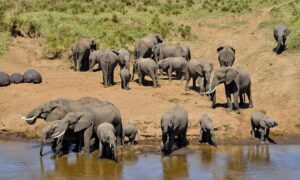
The Tarangire national park covers an area of 2,850 square kilometers protecting a variety of ecosystems consisting of Flora, fauna, and other tourist attractions. Among the flora species hosted in Tarangire national park there are the beautiful Baobab trees locally known as Mbuyu in Swahili, these trees grow to the average height of 30 meters and have 11 meters diameter thick, sturdy trunk and stunted root-like branches.
Fauna species in Tarangire national park include wildlife and bird species, in the park, there are 58 large mammal species with 700 resident lion individuals and during the dry season over 3,000 elephant species move to the plains of the park to drink water. Animals in the Tarangire national park include elephants, lions, wildebeests, gazelles, hartebeests, elands, antelopes, impalas, dik-dik, giraffes, waterbucks, banded mongoose, olive baboons, honey badgers, greater kudu, African wild dogs and many more.
Tarangire national park hosts over 550 bird species including Kori bustard, stocking-thighed ostrich, Kori bustard, hoopes, hornbills, crested francolin, stripped swallows, starlings, Hammerkops, bee-eaters, cordon bleus, owl’s plovers, and many more.
Tarangire national park offers a couple of Tanzania safari activities such as game drives (day and night game drives), birding safaris, nature walking safaris and cultural tours.
Learn More about Tarangire National Park
Udzungwa Mountains national park
Udzungwa Mountains national park is a wildlife national park located in central Tanzania region of Tanzania with Mikumi as the nearest city, this park was ranked as the 3rd best place to visit by the New York Times in 2015. Udzungwa Mountains national park is situated along Mikumi-Ifakara road at a distance of 60 kilometers south of Mikumi national park and about 380 kilometers from Dar-es-salaam the commercial capital of Tanzania.
Udzungwa Mountains national park covers an area of 1,990 square kilometers in size protecting a variety of flora and fauna, the park is dominated by tropical rainforest, mountain forest, miombo woodland, grassland, and steppe including 2500 plant species with 25% endemic species. Fauna Udzungwa Mountains national park includes 400 bird species and 6 primate species with endemic species such as Iringa red colobus and Sanje Mangabey.
Udzungwa Mountains national park is one of the richest birding habitat in Tanzania, birds hosted in this park include African Marabou, Crowned Eagle, Rueppell’s Vulture and the African Hobby with Francolin and Rufous-winged Sunbird, Udzungwa partridge, Harlequin Quail, little grebe, and many more.
Udzungwa Mountains national park offers excellent hiking and trekking safari activities which are the highlight activity in the park, these activities are mostly done on Sanje Waterfalls trail leading to Sanje waterfalls flowing at 170 meters with a plunge waterfall.
Tanzania National Reserves
Ngorongoro conservation area
Ngorongoro conservation area is one of the recognized wonders in the world located in the northern region of Tanzania in a distance of about 153 kilometers west of Tanzania, the conservation area lies in the northern safari circuit of tourism and is a distance of 139 kilometers from Tarangire national park, 213 kilometers from Arusha national park and 50 kilometers from Lake Manyara national park.

Ngorongoro conservation area is one of the scenic areas in the world hosting the world’s largest unbroken volcanic caldera “Ngorongoro crater” the main features of the area, the volcanic caldera is said to have been formed about 2-3 million years ago during a volcanic explosion and it 2,000 feet deep with a width of 260 square kilometers.
Ngorongoro conservation area is a unique destination and a UNESCO world heritage site declared in 1979 because of its beauty, Ngorongoro conservation area consists of other physical features such as craters (Olmoti crater and Empakaai crater), archeological sites such as Oldupai gorge, Ngoitokitok springs, Gol mountains, Mount Lolmalasin and Losirua, Laetoli footprints, Nasera rock, Lakes such as lake Magadi, Lake Ndutu and Lake Maseke, Munge stream and Rumbe hills.
Ngorongoro conservation area hosts 115 mammal species including lions, zebras, elephants, buffaloes, rhinos, leopards, elands, reedbucks, warthogs, hartebeests, bushbucks, serval cats, hyenas, black-backed jackals, topis, impalas, vervet monkeys olive baboons, and many more.
There are also a variety of birds in the Ngorongoro conservation area with over 550 bird species, these birds include Kenya Rufous sparrow, Livingstone turaco, Namaqua dove, Rufous-tailed Weaver, Speke’s weaver, white-naped raven eagle, white-eyed Slaty Flycatcher, white-naped raven, Hartlaub’s turaco, Hildebrandt’s Spurfowl and many more.
Ngorongoro conservation area offers amazing safari activities such as game drives, bird watching, walking safaris, archeological tours, cultural tours, and camping safaris.
Learn More about Ngorongoro conservation area
Selous game reserve
Selous game reserve is a game reserve in Kenya located in the southern-eastern region in the Miombo woodlands, the reserve lies in a distance range of 130 – 500 kilometers southwest of Dar-es-salaam and adjacent to Mikumi national park and Udzungwa mountains national park in the northwest and Kilombero game controlled area in the west.
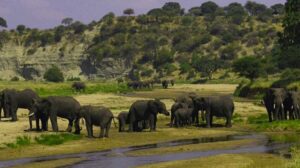
Selous game reserve was gazetted as a protected area in 1896 stretching over an area of 50,000 square kilometers, this reserve is the largest and oldest protected area in Africa. The landscape of the park is dotted with numerous lakes and rivers, lakes include Tagalala, Mzizimiz, Siwandu, Manze, and Nzelekela lakes. River Rufji flow through the reserve, this river is the largest river in Tanzania, and as it flows it forms a network of swamps and lakes.
Selous game reserve is a World Heritage Site declared in 1982. Selous national park hosts a great diversity of flora and fauna, the reserve is dominated by vegetation covers for example tickets, miombo woodlands, wetlands, and forests. Fauna species in this reserve include birds and wildlife species, animals in Selous national reserve include the largest elephant populations in all national parks found in Tanzania and Africa and more lions ever found on the continent of Africa. Animals found in Selous game reserve include greater kudus, waterbucks, hartebeests, zebras, giraffes, buffaloes, lions, African wild dogs, reedbucks, spotted hyenas, leopards, crocodiles, hippos and many more.
Selous game reserve hosts over 440 bird species such as spur-winged lapwing, African Wattled lapwing, African spoonbill, common white-headed vulture, brown-headed parrot, thick-billed cuckoo, white-backed night heron, bohm’s bee-eater, brown-headed parrot, African skimmer, Pel’s fishing owl, and many more.
In Selous game reserve safari activities include game drives, birding, walking safaris, boat safaris, fishing tours and cultural tours.
Uwanda game reserve
Uwanda game reserve in Tanzania is also known Uwanda Rukwa Game reserve is located in the southern region of Tanzania in the Sumbawanga district. Uwanda game reserve covers an area of 4100 square kilometers and 80% of the reserve’s area is covered by Lake Rukwa. Lake Rukwa is the main attraction in the park and a habit to flora and fauna of the reserve, the lake habits crocodiles, and its shores are dotted with acacias and miombo trees.
Uwanda game reserve is mostly water and papyrus of all the best national parks in Tanzania which makes it a breeding ground for over 350 waterbird species and migratory birds, these birds include kingfisher, sunbirds, woodpecker, grey parrots, red shark, African fish eagles, pelicans, lilac-breasted rollers, woolly necked stork, fish eagles, palm-nut vultures, ground hornbills, and the common sandpipers, among others. These birds usually nest on the shores of Lake Rukwa, in Lake Rukwa there are various species of fish such as mudfish, tilapia, sardines, and many more. Safari activities offered in Uwanda game reserve include boat rides, fishing safaris, birding, and walking safaris.




